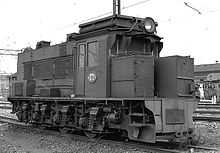South African Class DS1
| South African Class DS1 | |
|---|---|
|
Class DS1 shunting locomotive no. D138, c. 1940 | |
| Type and origin | |
| Power type | Diesel-electric |
| Designer | Allgemeine Elektricitäts-Gesellschaft |
| Builder | Allgemeine Elektricitäts-Gesellschaft |
| Serial number | AEG 5062/1939 (ESKOM locomotive) |
| Model | SAR DS1 |
| Build date | 1939 |
| Total produced | 2 |
| Specifications | |
| AAR wheel arr. | C |
| UIC classification | Co |
| Gauge | 3 ft 6 in (1,067 mm) Cape gauge |
| Wheel diameter | 42 in (1,067 mm) |
| Wheelbase | 11 ft 6 in (3.505 m) |
| Length |
27 ft 10 1⁄2 in (8.496 m) headstocks 30 ft 8 1⁄2 in (9.360 m) couplers |
| Height | 12 ft 6 3⁄4 in (3.829 m) |
| Axle load | 14 7⁄20 long tons (14.6 t) |
| Locomotive weight | 40 13⁄20 long tons (41.3 t) |
| Fuel type | Fuel oil |
| Fuel capacity | 289 imp gal (1,310 l; 347 US gal) |
| Prime mover | MAN 205 hp (153 kW) |
| Engine type | Diesel |
| Generator |
AEG 110 kW (150 hp) main AEG 12 kW (16 hp) auxiliary |
| Traction motors | Three AEG |
| Transmission | 5.67:1 gear ratio |
| Performance figures | |
| Power output | 205 hp (153 kW)[1] |
| Tractive effort | 78 kN (18,000 lbf) starting |
| Career | |
| Operator(s) |
South African Railways ESKOM |
| Class | Class DS1 |
| Number in class | 1 SAR, 1 ESKOM |
| Number(s) | D138, renumbered D514 |
| Official name | Citelec (ESKOM) |
| Delivered | 1939 |
| First run | 1939 |
The South African Class DS1 of 1939 was a South African diesel-electric locomotive from the South African Railways era.
The second diesel-electric locomotive on the South African Railways was a single Class DS1 AEG diesel-electric shunting locomotive that was placed in service in 1939. Two of these locomotives were delivered to South Africa, one for the Railways and another for the Electricity Supply Commission.[2]
Manufacturer
As a result of the problems experienced in obtaining adequate water supplies in the arid regions of South Africa and South West Africa, particularly on the section between De Aar in the Karoo via Upington to Keetmanshoop, the South African Railways (SAR) decided to experiment with diesel-powered traction and introduced its first two diesel-electric shunting locomotives in 1939.[2]
The second of these was a single locomotive with a Co wheel arrangement, of which two units were ordered from Allgemeine Elektricitäts-Gesellschaft (AEG) in Berlin at the same time as the single Class DS locomotive. Only one of them entered service on the SAR and was designated Class DS1. It was initially numbered D138, but it was soon renumbered to D514. Both numbers were actually in the electric locomotive number range.[2]
The second locomotive was delivered to the Electricity Supply Commission (ESCOM), the state-owned South African national power corporation, who placed it in service in Cape Town.[2]
Characteristics
The locomotive was powered by a Maschinenfabrik Augsburg-Nürnberg (MAN) 205 horsepower (153 kilowatts) eight-cylinder diesel engine prime mover. An AEG 110 kilowatts (150 horsepower) main generator and an AEG 12 kilowatts (16 horsepower) auxiliary generator were mounted directly in line between the engine and the cab. The engine was water-cooled, with a fan that was belt-driven by the engine and that drew air through a conventional radiator.[1][2]
This three-axle locomotive was essentially half a Class DS locomotive. Its single engine compartment was identical to either one of the two engine compartments of the Class DS. The cab was also identical to that of the Class DS, equipped with mechanically interlocked dual controls to enable operation in either direction.[2]
Service
South African Railways
The SAR Class DS1 was withdrawn from yard service in July 1956 and transferred to the SAR’s Civil Engineering department, who continued to use it for shunting at the Braamfontein electric repair shops in Johannesburg into the early 1960s.[2]

When it was finally retired from service and replaced by a Class S2 steam locomotive, it was plinthed on a short piece of track on the western side of the Braamfontein electric repair shops. The picture alongside shows the locomotive at Braamfontein, with the coupler mounted barely above track level and with the original coupler pocket blanked off. The reason for this modification is not known and is presumed to be related to the utilisation of the locomotive at the Braamfontein shops.[3]
ESKOM
The ESKOM locomotive was initially employed by the City of Cape Town at the Table Bay Power Station and was named "Citelek". It was later transferred to the Athlone Power Station in Cape Town, where it was scrapped in about 1966.[2]
See also
- Diesel-electric locomotive numbering and classification
- List of South African locomotive classes
- South African Class DS
- South African locomotive history
References
|
- ↑ 1.0 1.1 South African Railways and Harbours Locomotive Diagram Book, 2’0” & 3’6” Gauge Steam Locomotives, 15 August 1941, as amended
- ↑ 2.0 2.1 2.2 2.3 2.4 2.5 2.6 2.7 Paxton, Leith; Bourne, David (1985). Locomotives of the South African Railways (1st ed.). Cape Town: Struik. pp. 136–137. ISBN 0869772112.
- ↑ SAR-L Group: Message #44237 by Les Smith on 29 November 2012
.jpg)